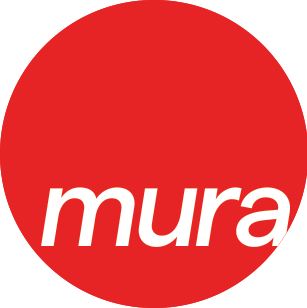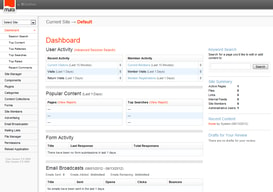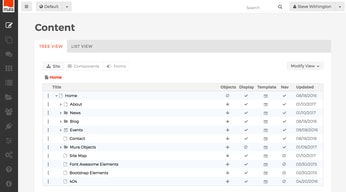

Unclaimed: Are are working at Mura CMS ?
Mura CMS Reviews & Product Details
Mura CMS is a content management platform that provides a user-friendly platform for managing and organizing website content. Its flexible architecture and robust set of features for managing dynamic websites, blogs, and e-commerce sites make it one of the preferred software in its space, with core features that include responsive design, SEO optimization, customizable templates, and multi-language support. Mura CMS is ideal for those looking for a powerful and flexible platform to manage their website content, with the ability to easily customize and extend the functionality to meet their specific needs.

( 1 )
| Capabilities |
|
|---|---|
| Segment |
|
| Deployment | Cloud / SaaS / Web-Based, On-Premise Linux, On-Premise Windows |
| Support | 24/7 (Live rep), Chat, Email/Help Desk, FAQs/Forum, Knowledge Base, Phone Support |
| Training | Documentation |
| Languages | English |






Compare Mura CMS with other popular tools in the same category.

Quick and easy to install and set up. Familiar web interface to people used to Wordpress
There isn't much to dislike about a free, open source CMS of this standard, apart from a slight lack of pre-packaged hosting options
Allowing non technical users to manage not just content, but approval and change sets
From a support point of view, we have almost no calls from our end-users. Their ability to pick up the product immediately was a huge plus. The development team helped us roll out integration with LDAP and we were good to go from there.
Even though I'm an avid ColdFuser, there are some limits to the amount of plug-ins available when compared with some other packages or languages. I had a harder learning curve initially when writing customizations, but once the initial curve was done I haven't had any issues.
We have our intranet based exclusively on Mura and have been using one version or another for several years. Good feedback from all involved. Have different sites broken out for various user groups and have had no problem with maintenance.
The Mura CMS has out of the box functionality that makes it easy to start with content management. I have used it for traditional content sites and as the backbone of more complex products, too. I like that it is so versatile.
Documentation is good but could be better. Learning to implement some functionality often requires combing through Google Groups.
I have deployed Mura to support multiple web sites, a complex e-commerce site, and a Human Resources application. It has been very fast and stable. The plug in architecture has allowed me to easily add features.
Mura is amazing at creating modern digital websites quickly. I have created specific-purpose websites in a matter of hours using responsive themes. On the other end of the spectrum, Mura is highly customizable. The class extension manager allows you to create forms with any feature you can imagine. You can then power those features further by adding CFML. I am not a programmer and can extend Mura's powerful out-of-the-box features quite easily. Beyond web sites, Mura is what I use as the CMS under my modern web app development. I like to combine MEAN stack-style functionality to Mura CMS. As a 30-year veteran of the tech game, I find the fact that Mura is offered for free to be quite mind-boggling. I would have killed for this amazing mix of features, extensibility and reliability decades ago.
As a non-programmer, setting up Mura is difficult for me. I tend to rely on Mura webhosts to get all the settings correct. I find setting up a local dev box time consuming. I'm also disappointed the Mura community has not grown faster over the last 6 years. It deserves a wider audience. I think that if Angular or ReactJS replaced jQuery as the base JS library/framework, it might get more attention.
I use Mura for websites that serve up training professional development. I have added custom training widgets to the Mura framework in order to use it as a learning content management system (LCMS).
I like the rich feature set included right 'out of the box'. You really can start right away without much customization. But I also really appreciate how extendable it is for developers to mold to customers business needs.
Nothing to dislike about Mura, except the don't ship In-N-out from their HQ in Sacramento.
Corporate websites, corporate intranets. Quick spin up time after initial setup. Very extendable for my clients custom requests to meet their business requirements.
The usability and easiness of using Mura CMS, as well as all the functionality that comes out-of-the-box. All of my clients that use Mura CMS to maintain their website have no issue getting used to the administrator interface and I therefor have very little work supporting them.
There is only a limited amount of themes and plugins available on the market. But since it's so easy to create your own or to convert an Bootstrap theme, you can get around this very easily. The same counts for the plugins. Nearly everything you might need is already available out-of-the-box and if not, Mura CMS is easily extendable.
I've bootstrapped a lot of websites very quickly with Mura CMS. And the great thing is that, once the sites get bigger, Mura CMS keeps a perfect solution to work with.
Mura has allowed us to quickly update content on the fly and build new pages in hours instead of weeks. One thing that my team enjoys using is the change-set feature. This has allowed us to create temporary changes to the website that are easy to roll-back. It seems the sky is the limit with Mura in terms of your creativity and your vision.
Our implementation was bumpy as we transitioned from our old platforms to Mura. We made our deadline but my team had to put in a lot of extra work that we were not planning on to get there.
Ownership and control over our website. Ability to make quick changes. Personalization and ABM experiences.
Mura CMS has a great feature set and is very easy to customize to meet site requirements. It has a long history and is about to release version 7. The development team behind the product is fantastic and eager to help potential developers and users of the platform.
As it is CFML-based, it does not have the adoption rate of some other CMS's available. This limits the plugins that exist in the wild when compared to other platforms such as Wordpress and Drupal.
I use Mura CMS to run a large non-profit website that features many different types of content, forms and e-commerce capabilities. Mura has added features over time and allowed us to provide more functionality for our staff and end users. We have also worked with the developers, Blue River Interactive, on a responsive theme for our site and they were a pleasure to work with.
CMS made easy with a interface that’s simple and user design that makes maintenance straightforward.
Not much except the one time where we were launching something new onto the site and it was hours delayed in uploading.
Maintaining tourism site for state Simple and straightforward for another agency or client to be able to take on.
Мура нічого не важко використовувати і адаптувати. Я ціную роботу з нею тонну. У вас буде більшість апаратів, які вам можуть знадобитися, щоб максимально використати сайти, які ви повинні зробити для кожного клієнта. Фронтальні зміни та формати роблять його менш вимогливим, щоб отримати те, що вам потрібно від Мурa. Ви можете змінити все, як вам подобається, що є великим. Це також неймовірно стійкий, ніколи не розбитий.
Документація велика, але може бути краще. Визначення того, як виконувати деяку корисність часто вимагає просіювання через різні Як новий вихід з нового клієнта, я був в залежності від онлайнової документації і обговорення мережі google, щоб дізнатися, і я регулярно відчуваю труднощі знайти саме те, що Мені потрібно. Збори.
Мура робить нам простим перерахувати нашу історію поступово. Крім того, ми перенесли багато нашої речовини з зовнішніх напрямків (Flipbook, Eventbrite і т.д.) послідовно на наш сайт, роблячи зустрічі гостей нашого сайту більш розумними.